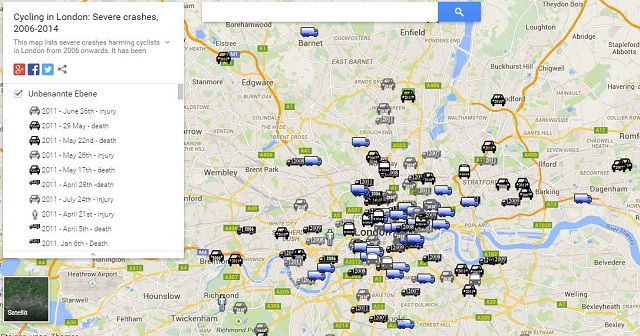
Cycling fatalities: much higher risk of getting killed by a lorry than a bus in London
Heavy Goods Vehicles are involved in a massive amount of fatal collisions all around Europe, in some countries more than a third of cycling fatalities are a result of a collision with a lorry. ECF's Road Safety Policy Officer Ceri Woolsgrove looked into the separate data on HGV and bus collisions with cyclists in London and found that there is a much higher risk of an HGV being involved in a fatal accident with a cyclist than a bus.

Heavy Goods Vehicles (HGVs) are involved in many cycling fatal collisions around Europe. HGVs make up around 3 percent of the European vehicle fleet and 7 percent of driven kilometres, yet they are involved in about 18 percent of all fatal collisions, costing over 7000 lives across the EU. Some 22 percent of cycling fatalities are as a result of collisions with a goods vehicle, both light and heavy goods vehicles[1], with wide variations across the EU. This figure is 43 percent in Belgium, 38 percent in the Netherlands, 33 percent in the UK and 33 percent in Denmark.
Dangerous manoeuvres
One of the major types of accidents is when a lorry makes a passenger side turn, it is difficult for drivers to really know what is going on in and around the cab on the passenger side of the lorry while cyclists are unaware of the dangers on that side of the vehicle.
ECF has been calling for better direct vision around all HGVs. In Europe there is in place indirect (use of mirrors) vision regulations that specify which mirrors to use, but there is nothing with regards to the direct vision of how the driver can see out of the cab window (unlike motor cars that do have direct vision requirements).
ECF has documented some of the issues with relying on indirect vision; incorrectly adjusted mirrors; broken mirrors; the time delay in checking up to 6 mirrors; warped mirror shape etc.[2] We also think that the cab of the majority of lorries are too high, the eye line of the driver in these cabs is getting on for 3 metres from the ground, the bottom lip of the side window is at around 2.5 metres. These cabs are unworkable in urban areas. Urban driving involves communication with other road users, it involves eye contact, hand signals, at the very minimum road users must be able to see around their vehicle. If these sorts of vehicles are allowed in urban areas then we have to bring the cab height down and introduce better windscreens and window side panels.
There is data for separate bus and HGV collisions
To illustrate this point I have often compared HGVs with buses. Buses would seem to have much better direct vision around their cabs, a lower seating position, wide open cab windows; if we assume that the drivers have the same training (CPC) and the infrastructure that they travel on is the same then if there is a difference in risk to cyclists we could say a fair proportion of blame must lie with the vehicle itself. So I thought I would delve a little deeper and see if I could tease out any differences in crash figures between the two. To find this I would need cyclist fatalities separated into bus and HGV collisions, as well as the number of kms driven by buses and HGVs within the city.
Almost all official data around Europe does not give us the differences between the two different vehicles in cyclist collisions, but Olaf Storbeck's blog that I cam across the oher day, diligently collects and catalogues cycling collisions in London. He has put together some useful tools such as this map that painstakingly lists cycling crashes and with which vehicle. The map looks like this:
 Google Maps/Olaf Storbeck data compilation
Google Maps/Olaf Storbeck data compilation
With this we can count and catalogue each cyclist fatality by vehicle type, the number of fatalities in total seem in line with the official data and so seem reasonably reliable (unfortunately not so for serious injuries so we must stay with fatalities).
I also managed to find the number of vehicle kilometres of trucks and buses in London to give some sort of comparable assessment[3], and not only in London as a whole but borough by borough meaning we could even differentiate between sections of the city.
Much higher risk of an HGV involved in a fatal accident with a cyclist than a bus
I took Olaf’s accident data from 2009 to 2013 but found that the number of vehicle KMs data runs from 2005 to 2010 so I took a one year average of the vehicle km and used that as the number of vehicle kms for every year. I also took an average number of fatalities over the 5 year period in case of one or two years being out of the ordinary. So I would have a year average number of bus and HGV average cyclist fatalities for a 5 year period from 2009-2013, and year average number of vehicle kms for between 2005 and 2010.
My results were that in London as a whole for HGVs there were 41 HGV/cyclist fatalities over that time, an average of 8.2 per year, and an average of 884 million HGV vehicle km; that is 1 fatality per 108 million km.
For the bus/cyclist fatalities there was an average of 1.3 fatalities per 430 million vehicle km; that is one fatality every 331 million vehicle km.
That is three times higher risk of an HGV being involved in a fatal accident with a cyclist than a bus.
However we can also work out the data for inner London, (you could even do it borough by borough if you have the time), since that is where the majority of these accidents happen. For inner London we get the following:
- HGV/cyclist 6.8 fatalities per 189 million km, equals 1 fatality per 28 million km
- Bus/cyclist 1.2 fatalities per 169 million km, equals 1 fatality per 140 million km
That is five times higher risk of an HGV being involved in a fatal accident with a cyclist than a bus.
There is room for improvement of the data collection
An unscientific quick and dirty study but interesting nevertheless; what would be interesting is to look also at serious injuries and comparing serious injuries, or even incidents. Unfortunately I don’t think Olaf’s data is as complete for serious injuries, neither does the official data differentiate.
The other thing it tells us is that since the figures were different for inner London and London as a whole perhaps it is more than just vehicle differences between the figures, or indeed the type of HGV or bus. We also have to remember that there may be more cyclists in inner London, hence the higher figures overall (but would not explain the high difference between bus and HGV). It would be useful to carry this on and find other ways of improving this, London is useful because it does have data, budget and resources for data collection, it is in some ways a small country but composed of one big urban area, so is interesting to look at with regards to cycling data.
If you have any interesting data that could contribute to providing good evidence to improve vehicle safety for cyclists and pedestrians, then by all means contact me (c.woolsgrove@ecf.com) and we can provide the European Commission with it. It does not have to be in English can be city or national statistics, we will take whatever there is (as you can see above!). I would also really appreciate if I could get information on dooring incidents, where vehicle occupants open their doors onto oncoming cyclists.
Amendment of safety regulations on the horizon
Next year Brussels will enter into a procedure to amend the General Safety Regulations of all vehicles, not just cross border HGVs but all HGVs and all motorised vehicles. As you can see it is difficult to get good data that can show specifically where the problems occur. At ECF we think that HGV direct vision and height of the HGV cab is an essential element to start to improve. We also look at which type of HGV is involved in most crashes, as well as active safety systems for all vehicles.
[1] Pedalling towards Safety, ETSC, http://archive.etsc.eu/documents/BIKE_PAL_Safety_Ranking.pdf
[2] http://ecf.com/files/wp-content/uploads/ECF-report-on-HGV-cabs-direct-vision-and-amendments-to-Directive-96_3.pdf
http://ecf.com/news/opinion-can-the-eu-make-lorries-safer-across-the-eu/
[3] http://www.tfl.gov.uk/assets/downloads/traffic-note-1-traffic-levels-in-greater-london-2010.pdf
About the author
 Ceri Woolsgrove is ECF’s Road Safety & Technical Issues Policy Officer, he works on everything from road safety through HGV design to helmets.
Ceri Woolsgrove is ECF’s Road Safety & Technical Issues Policy Officer, he works on everything from road safety through HGV design to helmets.- Log in to post comments
Contact the author
Recent news!
Upcoming events
Contact Us
Avenue des Arts, 7-8
Postal address: Rue de la Charité, 22
1210 Brussels, Belgium









